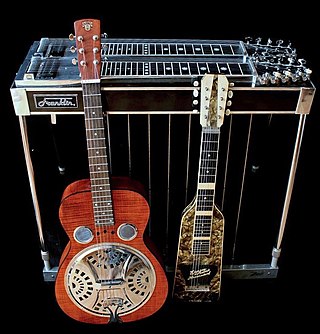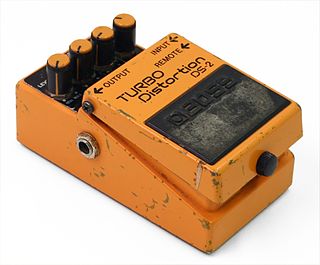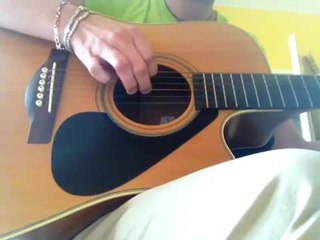Related Research Articles

An electric guitar is a guitar that requires external amplification in order to be heard at typical performance volumes, unlike a standard acoustic guitar. It uses one or more pickups to convert the vibration of its strings into electrical signals, which ultimately are reproduced as sound by loudspeakers. The sound is sometimes shaped or electronically altered to achieve different timbres or tonal qualities from that of an acoustic guitar via amplifier settings or knobs on the guitar. Often, this is done through the use of effects such as reverb, distortion and "overdrive"; the latter is considered to be a key element of electric blues guitar music and jazz and rock guitar playing. Designs also exist combining attributes of the electric and acoustic guitars: the semi-acoustic and acoustic-electric guitars.

Funk is a music genre that originated in African American communities in the mid-1960s when musicians created a rhythmic, danceable new form of music through a mixture of various music genres that were popular among African Americans in the mid-20th century. It de-emphasizes melody and chord progressions and focuses on a strong rhythmic groove of a bassline played by an electric bassist and a drum part played by a percussionist, often at slower tempos than other popular music. Funk typically consists of a complex percussive groove with rhythm instruments playing interlocking grooves that create a "hypnotic" and "danceable" feel. Funk uses the same richly colored extended chords found in bebop jazz, such as minor chords with added sevenths and elevenths, or dominant seventh chords with altered ninths and thirteenths.

The guitar is a fretted musical instrument that typically has six strings. It is usually held flat against the player's body and played by strumming or plucking the strings with the dominant hand, while simultaneously pressing selected strings against frets with the fingers of the opposite hand. A plectrum or individual finger picks may also be used to strike the strings. The sound of the guitar is projected either acoustically, by means of a resonant chamber on the instrument, or amplified by an electronic pickup and an amplifier.
Heavy metal is a genre of rock music that developed in the late 1960s and early 1970s, largely in the United Kingdom and United States. With roots in blues rock, psychedelic rock and acid rock, heavy metal bands developed a thick, monumental sound characterized by distorted guitars, extended guitar solos, emphatic beats and loudness.

Jazz guitar may refer to either a type of electric guitar or a guitar playing style in jazz, using electric amplification to increase the volume of acoustic guitars.

In music performances, rhythm guitar is a technique and role that performs a combination of two functions: to provide all or part of the rhythmic pulse in conjunction with other instruments from the rhythm section ; and to provide all or part of the harmony, i.e. the chords from a song's chord progression, where a chord is a group of notes played together. Therefore, the basic technique of rhythm guitar is to hold down a series of chords with the fretting hand while strumming or fingerpicking rhythmically with the other hand. More developed rhythm techniques include arpeggios, damping, riffs, chord solos, and complex strums.

Slide guitar is a technique for playing the guitar that is often used in blues music. It involves playing a guitar while holding a hard object against the strings, creating the opportunity for glissando effects and deep vibratos that reflect characteristics of the human singing voice. It typically involves playing the guitar in the traditional position with the use of a slide fitted on one of the guitarist's fingers. The slide may be a metal or glass tube, such as the neck of a bottle. The term bottleneck was historically used to describe this type of playing. The strings are typically plucked while the slide is moved over the strings to change the pitch. The guitar may also be placed on the player's lap and played with a hand-held bar.

A steel guitar is any guitar played while moving a steel bar or similar hard object against plucked strings. The bar itself is called a "steel" and is the source of the name "steel guitar". The instrument differs from a conventional guitar in that it is played without using frets; conceptually, it is somewhat akin to playing a guitar with one finger. Known for its portamento capabilities, gliding smoothly over every pitch between notes, the instrument can produce a sinuous crying sound and deep vibrato emulating the human singing voice. Typically, the strings are plucked by the fingers of the dominant hand, while the steel tone bar is pressed lightly against the strings and moved by the opposite hand.

A power chordPlay (help·info) is a colloquial name for a chord in guitar music, especially electric guitar, that consists of the root note and the fifth, as well as possibly octaves of those notes. Power chords are commonly played on amplified guitars, especially on electric guitar with intentionally added distortion or overdrive effects. Power chords are a key element of many styles of rock, especially heavy metal and punk rock.
The palm mute is a playing technique for guitar and bass guitar, executed by placing the side of the picking hand below the little finger across the strings to be plucked, very close to the bridge, and then plucking the strings while the damping is in effect. This produces a muted sound. The name is a slight misnomer, as the muting is performed by the side of the hand, not the palm.

Slapping and popping are ways to produce percussive sounds on a stringed instrument. It is primarily used on the double bass or bass guitar. Slapping on bass guitar involves using the edge of one's knuckle, where it is particularly bony, to quickly strike the string against the fretboard. On bass guitars, this is commonly done with the thumb, while on double bass, the edge of the hand or index finger may be used. Popping refers to pulling the string away from the fretboard and quickly releasing it so it snaps back against the fretboard. On bass guitar, the two techniques are commonly used together in alternation, though either may be used separately.

The lap steel guitar, also known as a Hawaiian guitar, is a type of steel guitar without pedals that is typically played with the instrument in a horizontal position across the performer's lap. Unlike the usual manner of playing a traditional acoustic guitar, in which the performer's fingertips press the strings against frets, the pitch of a steel guitar is changed by pressing a polished steel bar against plucked strings. Though the instrument does not have frets, it displays markers that resemble them. Lap steels may differ markedly from one another in external appearance, depending on whether they are acoustic or electric, but in either case, do not have pedals, distinguishing them from pedal steel guitar.

Fingerstyle guitar is the technique of playing the guitar or bass guitar by plucking the strings directly with the fingertips, fingernails, or picks attached to fingers, as opposed to flatpicking. The term "fingerstyle" is something of a misnomer, since it is present in several different genres and styles of music—but mostly, because it involves a completely different technique, not just a "style" of playing, especially for the guitarist's picking/plucking hand. The term is often used synonymously with fingerpicking except in classical guitar circles, although fingerpicking can also refer to a specific tradition of folk, blues and country guitar playing in the US. The terms "fingerstyle" and "fingerpicking" also applied to similar string instruments such as the banjo.
In popular music, a fill is a short musical passage, riff, or rhythmic sound which helps to sustain the listener's attention during a break between the phrases of a melody. "The terms riff and fill are sometimes used interchangeably by musicians, but [while] the term riff usually refers to an exact musical phrase repeated throughout a song", a fill is an improvised phrase played during a section where nothing else is happening in the music. While riffs are repeated, fills tend to be varied over the course of a song. For example, a drummer may fill in the end of one phrase with a sixteenth note hi-hat pattern, and then fill in the end of the next phrase with a snare drum figure.
Funk rock is a fusion genre that mixes elements of funk and rock. James Brown and others declared that Little Richard and his mid-1950s road band, The Upsetters, were the first to put the funk in the rock and roll beat, with a biographer stating that their music "spark[ed] the musical transition from fifties rock and roll to sixties funk."

Distortion and overdrive are forms of audio signal processing used to alter the sound of amplified electric musical instruments, usually by increasing their gain, producing a "fuzzy", "growling", or "gritty" tone. Distortion is most commonly used with the electric guitar, but may also be used with other electric instruments such as electric bass, electric piano, synthesizer and Hammond organ. Guitarists playing electric blues originally obtained an overdriven sound by turning up their vacuum tube-powered guitar amplifiers to high volumes, which caused the signal to distort. While overdriven tube amps are still used to obtain overdrive, especially in genres like blues and rockabilly, a number of other ways to produce distortion have been developed since the 1960s, such as distortion effect pedals. The growling tone of a distorted electric guitar is a key part of many genres, including blues and many rock music genres, notably hard rock, punk rock, hardcore punk, acid rock, and heavy metal music, while the use of distorted bass has been essential in a genre of hip hop music and alternative hip hop known as "SoundCloud rap".
Jimmy Nolen was an American guitarist, known for his distinctive "chicken scratch" lead guitar playing in James Brown's bands. In its survey of "The 100 Greatest Guitarists of All Time," the English magazine Mojo ranks Nolen number twelve.

Guitar picking is a group of hand and finger techniques a guitarist uses to set guitar strings in motion to produce audible notes. These techniques involve plucking, strumming, brushing, etc. Picking can be done with:
Damping is a technique in music for altering the sound of a musical instrument by reducing oscillations or vibrations. Damping methods are used for a number of instruments.
References
- 1 2 Appell, Glenn; Hemphill, David (2006). American Popular Music: A Multicultural History. Thomson Wadsworth. p. 320. ISBN 0-15-506229-8 . Retrieved 2012-01-17.
- ↑ Williams, Richard (2010). The Blue Moment, p.210. W. W. Norton. ISBN 9780393076639.
- 1 2 The Wire. Vol. 173–178. C. Parker. 1998. p. 28. Retrieved 2012-01-17.
- ↑ Woods, Tricia; Green, Raleigh (2008). The Versatile Guitarist National Guitar Workshop. Alfred Music Publishing. ISBN 978-0-7390-4805-4 . Retrieved 2012-01-17.
- 1 2 Shapiro, Peter (2006). Turn the Beat Around: The Secret History of Disco. Macmillan. pp. 53, 94. ISBN 0-86547-952-6 . Retrieved 2012-01-17.